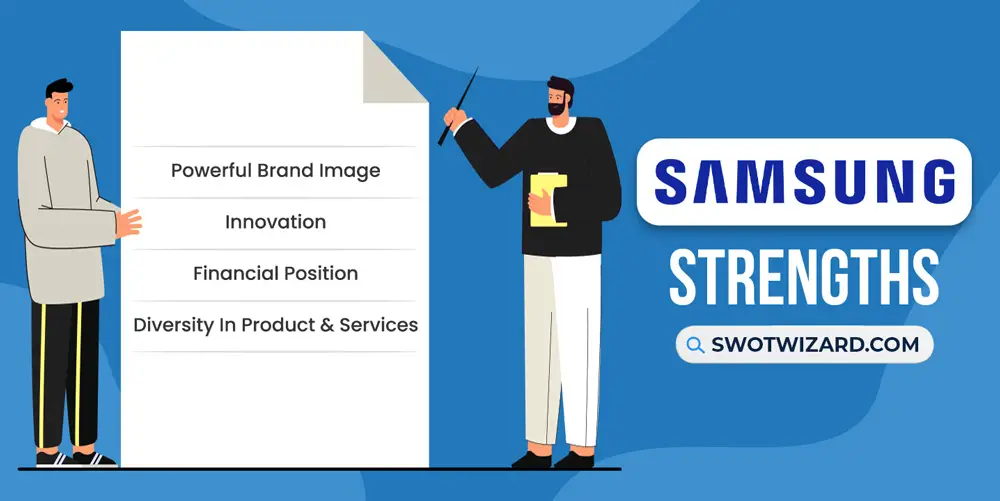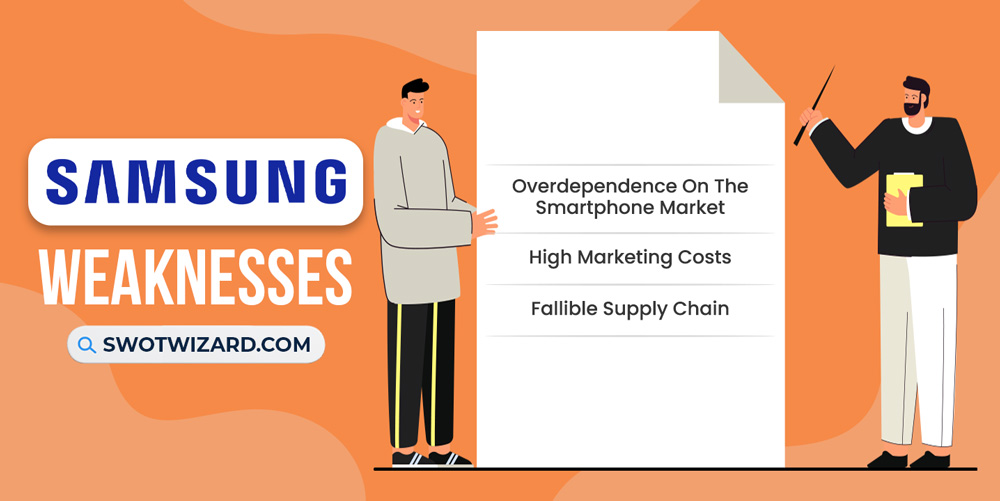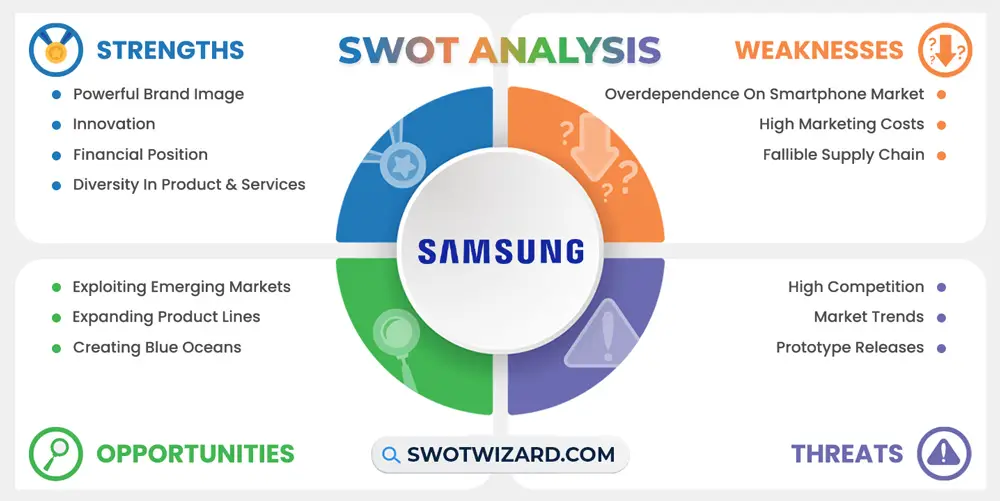From a small trading company with only 40 employees, Samsung has turned into a tech monolith holding the position of the 25th largest company by market cap (last seen on 27 december, 222). From introducing super AMOLED displays, and biometrics on phones to making the first-ever IP68 smartphone, Samsung has been spearheading change in the tech industry for decades. So, let’s take a look at the Samsung SWOT analysis to understand what this company has and will achieve in the years to come.
Samsung: Company Overview
| Company | Samsung |
| Industry | Conglomerate |
| Founded | 1 March 1938 |
| Founder | Lee Byung-chul |
| Chairman | Lee Jae-yong |
| Headquarter | Seocho District, Seoul, South Korea |
| No. of Employees | 287,000+ |
| Annual Revenue | 279 KRW Trillion (FY 2021) |
| Website | www.samsung.com |
Samsung started as Samsung Sanghoe in 1938, a small trading company with only 40 employees, founded by Lee Byung-Chul. It wasn’t until 1980 that the company invested in telecommunications hardware, and its mobile phones and semiconductors gained international acclaim after 1990. The company has gone on to produce over 300 million smartphones in 2020 alone.
The conglomerate is currently headed by Lee Jae-yong, and it’s headquartered on the 40th floor of the Samsung Electronics Building, 11, Seocho-daero 74-gil, Seocho District, Seoul, South Korea. Samsung is regarded as the world’s largest manufacturer of DRAMs, SSDs, NAND flash memory cards, TVs, fridges, and smartphones. The company now has a market cap of $310.44 billion, and in 2020 it was $500.83 billion.
Product & Services of Samsung
Smartphones | Tablets | Monitors | 4k UHD | Hospitality TVs | Galaxy Books | Watches | Memory & Storage
Samsung Competitors
Apple | LG | Sony | HTC | Huawei | Intel | Electrolux | Lenovo | Panasonic | Whirpool
Did You Know?
While Samsung is known in the international space as a tech giant, it’s a conglomerate that invests in industries such as safety data sheets, shipbuilding, military defense, life insurance, construction, fire and marine equipment, and even food. In fact, it was Samsung C&T that built Burj Khalifa, Petronas Twin Towers, and Taipei 101.
Strengths – Samsung SWOT Analysis

Powerful Brand Image: In the tech market, Samsung is seen as a symbol of quality, excellence, and innovation. Samsung’s products, especially their smartphones and tablets, are considered superior to most other android brands. In 2022, there have been over 2.8 active android users, and over 1.033 billion users have a Samsung smartphone.
Most consumers in the tech industry consider Samsung products as the standard to measure other companies’ products. In 2018, over 55% of Canadian consumers trusted Samsung smartphones over other brands, ranking the company as the 6th most trusted company in Canada.
For employees, Samsung is one of the most lucrative and relaxed companies to work for. Samsung makes it a habit to let employees clock in till 6 PM if they’re not feeling creative or conductive early. Forbes listed Samsung as the world’s best employer and ranked the company 84th best employer for veterans in 2022.
Innovation: Samsung has been leading the charge when it comes to innovation in most industries for decades. The company has a huge park devoted mostly to research and development called Samsung Digital City. The company devotes a lot of its resources and effort here to inventing, testing, and finalizing new technology. This includes their famous Galaxy smartphone lineup, TV, monitor, smartphone screens, semiconductors, chipsets, and more.
In the TV space alone, Samsung has been the world’s first to make edge-lit LED, 3D LED, curved UHD, and SUHD TVs. In the smartphone market, Samsung was the first to make AMOLED displays, introduce biometrics, mobile payment, curved display, dual aperture camera, and achieved an IP68 rating and wireless charging. In 2020, Samsung had over 300,000 active patents.
Financial Position: In the 3rd quarter of 2022, Samsung reported a total of $336,637,178 in assets to its shareholders. Over $164,489,506 of it was non-current assets or long-term investments. Samsung’s stock is going for $45.14 on December 23, 2022, with a trailing P/E of 14.45 and forward P/E of 9.41. Financially, Samsung has all the indicators of a future-proof company and a great investment opportunity.
Diversity In Product & Services: Samsung is a conglomerate that has invested heavily in almost every industry fathomable. The diversity of their product and service helps them sell and generate revenue in multiple industries, instead of relying on a single market. In the tech industry alone, the company competes in smartphones, tablets, smart devices, cybersecurity, semiconductor, displays, appliances, smart wearables, and more.
This diversity also allows Samsung to spread across international markets and streamline its resourcing process. The company can source any material or technology they need easily and cheaply. Also, Samsung is the biggest manufacturer of semiconductors and displays. This means it can simultaneously reduce component costs, increase production, and control competitors’ revenue and product manufacturing rates.
Weaknesses – Samsung SWOT Analysis

Overdependence On The Smartphone Market: Samsung makes over 20% of its revenue from the smartphone market. A good majority of Samsung’s revenue hinges upon smartphone market trends and consumer demands. It’s a risky decision that can easily drop revenue based on competitors’ offerings, market conditions, and consumer decisions.
In fact, in 2020, Samsung sold over 253 million units, which was 18.8% of the global market share. But in 2021, the company sold 203.4 million units and only 200 million units in 2022. This is significantly impacting the company’s profit margins.
High Marketing Costs: Samsung re-invests most of its profits back into the company, and a large margin of it goes to marketing. In 2018, Samsung spent $2.15 billion on marketing, which was the highest amount spent globally. In 2021, it spent $2.3 billion. Samsung is risking communication cluttering in marketing, and it’s not making money back.
Fallible Supply Chain: Samsung’s global supply chain can be easily jeopardized due to any international altercation. International policies, politics, hostility towards foreign companies, and other issues can easily affect Samsung’s resourcing, manufacturing, and shipping processes.
Opportunities – Samsung SWOT Analysis

Exploiting Emerging Markets: Being an international company, Samsung can invade emerging markets such as Asia, Latin America, and Africa quite easily. It has the resources and connections to investigate markets, local competition, and prospective partners. The company can easily create customized products for specific demographics, sell and market through local partners, and dominate these markets.
Expanding Product Lines: Samsung already makes displays, semiconductors, and other components needed for many tech products. The company can easily manufacture and launch other product lines, such as smart electric vehicles, desktop processors, graphics cards, motherboards, and more.
Creating Blue Oceans: As a conglomerate, Samsung has already invested in nearly every industry and sold in many markets. Using their market research, they can identify consumer needs or wants and combine resources and connections across different industries to create entirely new markets through their products.
Threats – Samsung SWOT Analysis

High Competition: Samsung faces a lot of competition in the tech industry and has been recently eclipsed by companies like Apple, Microsoft, and Google and heavily pursued by Nothing, Anker, Oura, SiFive, and more. These companies are offering services and products that are similar and sometimes superior in quality or pricing.
Market Trends: Samsung, along with Apple, Google, OnePlus, and a few other companies, control the smartphone market and sets up expectations. However, companies like Xiaomi, Realme, Nothing, and others are constantly coming up with budget-friendly phones with powerful specifications. Asus, Blackshark, Nubia, and Sony are making gaming-focused phones that are constantly challenging the flagship models that Samsung’s pushing out.
As Samsung draws over 20% of its revenue from the smartphone industry, a slight shift in market trends or consumer preference can cause the company to lose heavily. With smaller smartphone lineups constantly trying to one-up the market leaders, Samsung has a real chance of experiencing months of low sales or virtually no sales for some models.
Prototype Releases: Samsung often pushes the boundaries, releasing new technology and products for consumer use before its ready. Samsung’s Galaxy Note 7 had a faulty battery that caught fire and caused many consumers to experience severe burns. The fiasco caused Samsung over $5.3 billion to fix and severely damaged its reputation.
Samsung’s most recent and newsworthy lineup was the Galaxy Fold, which is a flagship lineup featuring foldable screens. Unfortunately, the 1st iteration of the phone had a hinge that could easily get dust in it and damage the phone. There are many other products that Samsung has sold to consumers at its prototype stage, and every future decision to do so can permanently mutilate the company’s brand image and market share.
[Bonus Infographic] SWOT Analysis of Samsung

Recommendations for Samsung
To hold its market presence and dominate over its competitors, Samsung should consider these recommendations:
- Samsung should slow down its aggressive marketing tactics and spend less overall on traditional marketing tactics.
- The company should spend more time testing products and new technology before releasing them on the market for consumer use.
- The company should invest more in sponsorships and continue building its nature-friendly image.
- Samsung should aim for the graphics card market, as the only 3 companies in the market, Nvidia, AMD, and Intel, are aiming for the high-spending consumers, leaving the budget-friendly bracket wide open.
Frequently Asked Questions (FAQs)
Is Samsung a reliable brand?
Although Samsung has had its fair share of mishaps over the years, it has a track record of reliability, innovation, and quality. Samsung is seen as a prestigious brand by many consumers across the world and a top contender in the flagship smartphone bracket.
How large is Samsung?
Samsung invests in just about every possible industry globally and is the largest manufacturer of semiconductors and displays in the world. The company has an entire park in South Korea devoted to its research and management, and it produced $241.60 billion total in revenue in 2022. The company currently employs over 266,673 people and is in the top 35% in retaining employees among similarly sized companies.
Final Words on Samsung SWOT Analysis
Although Samsung is a market leader when it comes to electronics components, smartphones, and TVs, it has slowly lost ground to other companies in many markets over the years. The loss can be largely attributed to Samsung’s aggressive marketing and manufacturing of its phones during the pandemic. However, even with the losses it has sustained and the mistakes it has made, Samsung has rooted itself deeply in the tech industry, and will not go anywhere in the decades to come.
References
- Wikipedia contributors. (2022, December 27). Samsung. Wikipedia
- BBC News. (2017, January 23). Samsung confirms battery faults as cause of Note 7 fires. BBC News.
- CURRY, D. (2022, August 10). Android Statistics (2022). Business of Apps.
- Samsung (005930.KS) – Market capitalization. (n.d.). CompaniesMarketCap.
- Samsung Retention Score. (n.d.). Comparably.
- Samsung Electronics | Company Overview & News. (n.d.). Forbes.
- Samsung Electronics Co Ltd (005930) Stock Price & News. (n.d.). Google Finance.
- Jay, A. (2022, November 6). Number of Smartphone and Mobile Phone Users Worldwide in 2022/2023: Demographics, Statistics, Predictions. Financesonline.com.
- Laricchia, F. (2022, November 24). Global smartphone unit shipments of Samsung 2010-2022. Statista.
- Purdy, K. (2019, April 23). Here’s Why We Think Galaxy Folds Are Failing. iFixit.
- Our Business | About Us. (n.d.). Samsung.
- [Infographic] Looking Back on Samsung’s TV Innovations Over the Years. (2020, March 19). Samsung.
- History – Corporate Profile – About Samsung. (2008, November 11). Samsung.
- 20 Things You Didn’t Know about Samsung’s Headquarters in Suwon. (2014, September 14). Samsung.
- 10 for 10: Highlights from a Decade of Galaxy Innovation. (2019, August 1). Samsung.
- Financial Statements. (n.d.). Samsung.
- Statista [Statista Research Department]. (2022, August 26). Samsung: ad spend in the U.S. 2014-2021. Statista.
- CONSTRUCTION | Burj Khalifa tickets. (n.d.). Burj Khalifa.




